Introduction
Researchers have created an impossible amalgam of contradictory evidence called Ancient Egypt. On one hand, there is the Egypt of Collossi of Memnon and on the other is the Egypt of Ramesis II. Both are wrapped into the Ancient Egypt narrative. The fantasy assertion that everyone before the Pleistocene Catastrophe, (PC, death of the Mega Fauna), was a spear thrower has precluded all other considerations. Egypt only makes sense if it is viewed as a product to two civilizations, one Ancient Egypt and the other Antecedent Egypt. This and the next article will detail how the latter achieved their remarkable accomplishments.
Two individuals provided seminal insight into understanding Antecedent Egyptian1 (AnE) technology. Both have been assiduously ignored by researchers. The first is Michael T. Wright who built a working replica of the Antikythera Mechanism. This machine is without the most important archaeological find of modern history. Micheal Wright's accomplishment is crucial to understanding Egypt's past. The device proves knowledge of analog computing was known in the very ancient past. By the time of its construction, analog computers were being used to create expensive toys. Regrettably, the instrument also represented the closing chapter on AnE technology. The decline wasn't reversed until the Medici of Florence spent vast sums acquiring, translating, copying and lending ancient manuscripts salvaged from the expiring Eastern Roman Empire. The Medici patronage was the driving force behind the Renaissance's New Learning from which modern science arose.
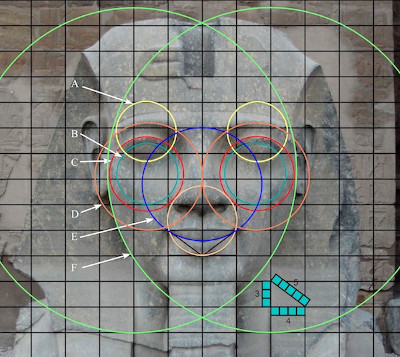
Figure 1
The second person providing critical insight into Egypt's past is Christopher Dunn.2 He made a number of very important contributions to untangling the enigma of Ancient Egypt. In a detailed study of Ramesis II's statue, fig.(1), at Luxor, he demonstrated the precise geometric relationships surrounding the different features of Ramesis' face. What his research demonstrated was that the Ramesis statue was not a portrait but a caricature of a man. It was not the product of hammer and chisel. Only analog computer programs could have created the precision that Chris Dunn demonstrated existed on Ramesis' face. Using such modules, AnE created these iconic statues.
The iconic Egyptian statues were made according to strict parameters. Regardless of the size, the figure was divided from forehead to feet into eighteen rows of squares. The subject was either sitting or was walking out of a wall. Limiting statues to two positions reduced the number of modules needed to create a statue. Having the sculptures bound within strict parameters is exactly what would be expected if the sculpting was controlled by analog computers. Crafting such modules was not a simple undertaking, as Michael Wright demonstrates in his reconstruction of the Antikythera Mechanism.3

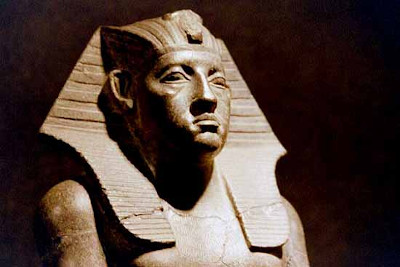
Figure 2
Comparing the two images of Amenemhat III, figs.1(a-b), the differences are apparent. The ears, fig.1(a), are too large for the head. Furthermore, the nemes, or headdress, falls immediately behind and blends with the ears, so it is too far forward. In comparison, the nemes of fig.2(b) was rendered correctly with the ears separate and distinct. This means ears were crafted separately from the head. Comparing the nemes' between figs.2(a-b), other differences were apparent. The nemes of fig.2(a) is crafted correctly up to the fold at the shoulder, but had to be manually graved above that point. For comparison, the headpiece of fig.2(b), with its sculpted pleats above the fold, was rendered correctly. The over-sized ears indicate that the analog module used to sculpt the ears of fig.2(a) may have been for a larger head. Since the ears did not fit the head, a module for applying pleats suitable for this head, for some reason, was not used. Therefore, the craftsman had to manually grave the lines to give the appearance of pleats. In order to keep analog modules as simple as possible, each sculpted a single part of the face. As a module's complexity increased, so did the difficulty in controlling the mechanism's output.
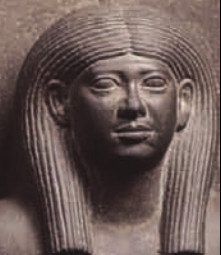
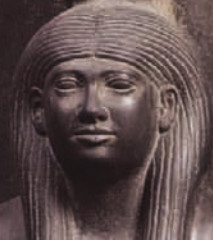
Figure 3
The images from a triad found at Menkaure Valley Temple, fig.3(a-b), indicated two different craftsmen worked on the sculpture. The person who graved the plaits, fig.3(a), took greater care in his work. The engraving is more evenly distributed across the wig. Gaps between the plaits on fig.3(b) are not so evenly rendered. Hand graving the wigs was probably due to the complexity of creating a machine to do them. Note also the faces of fig.3(a-b) are identical. This was partially masked by turning the face of fig.(b) slightly to the viewers left. Such precise duplication could only be achieved mechanically, but it also reduced expenses.
If analog modules were used, one would expect to find statues sharing features that were exactly duplicated like the above images. A workshop would repeatedly use the same analog module to craft the same feature on different statues. In a study of Egyptian statues, exact duplication is what Mahmoud Awad Kessem found. Exact matches were found shared among ears, legs and sndyt, (a short kilt) between different sculptures. For example, in fig.4, each left foot has the same turned out little toe. He also determined some female figures associated with statues were copies, fig.3. A hammer and chisel can not make duplicates. If forensic analysis were done on Egyptian statues like what Chris Dunn accomplished, it might be possible to determine how many manufacturing workshops were involved4.

Figure 4
What masquerades as evidence in Egypt has become bizarre. For example, Dimitri Laboury's Portrait versus Ideal Image reads like some dialectical treatise by a communist ideologue from the early 20th century.5. Regarding Egyptian statuary, he used psycho-babble phrases, like 'borrowed personality', 'love of realism' and 'dialectic portrait versus ideal image'.6 Such nonsense has become acceptable. The unacceptable is book burned. Book burning is a narrative control tool used by academics. For example, Chris Dunn's critically important work will never appear in any research papers. His investigations represent a huge semaphore warning research is in the ditch. He set a new benchmark for the study of Egypt, but the response was to burn it. Litmus testing archaeological evidence has created enigmatic Egypt. This anti-intellectualism has given rise to cockroach science where fantasy evidence is crafted to justify baseless assertions.

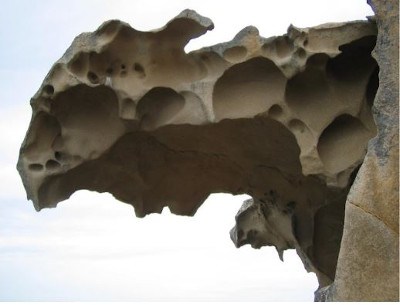
Figure 5
To understand the AnE accomplishments, it is necessary to review evidence on Sardinia. Since the appearance of ZPAs (Z-Pinch Aurora) was documented by Neolithic Sardinians, two effects can be attributed to plasma, it transforms rock into plasma and it levitates, fig,2(a,b). Because plasma exerts a force like gravity, the very large boulder, fig.2a, was shaped and picked up from another location and place here. In fig.2b, the precision with which plasma shapes rock can be seen. No obvious signs of transition can be seen on the various edges of the rock. Temporary alteration did occur in the rock which will be covered below. When analog modules like Michael T. Wright's Antikythera Mechanism were combined with plasma, AnE accomplishments can be understood. By harnessing these properties of plasma, they were able to move and shape massive stones. Antecedents had tens of thousands of years to perfect their technology. The precision of plasma is critical to understanding the accomplishments of AnE.
If the reader thinks this suggestion is over the top, a review of Edward Leedskalnin and his Coral Castle is required. Leedskalnin, with only a fourth grade education, was remarkably creative. He quarried and moved five ton blocks of coral used to build the Castle. He is said to have remarked that he knew how Egyptians built the great pyramid. Leedskalnin was book burned too. The only reason this suggestion appears strange is that the knowledge of plasma science has been suppressed. As Nobel Laureate Hannes Alfven, who Dr. Anthony Peratt called the dean of plasma scientist, complained that he could not get his papers published in major journals, (book burning). Plasma will drive a new industrial revolution.
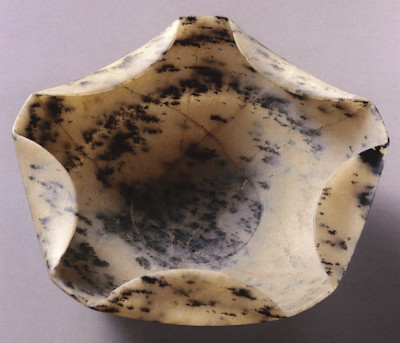

Figure 6
There is absolutely no difference in precision between images fig.5b and fig.6(a,b) except one was a natural formation and the other is man made. Fig.6(b) is a funnel with a very thin wall. The stone was milled down to a thin layer without rendering the vessel wall unstable. This indicates that the craftsmen were able to control plasma's intensity with micro-adjustments. By these means, they were able to create the 'single point stability' vessel, fig.10(b) part 1. The vessel in fig.6(a) probably started as a round bowl. The rock's rigidity was sharply reduced when plasma was applied during the manufacturing process. The rock became malleable. After the bowl was formed, the sides could then be folded slightly inward. Once a vessel was completed, a period of 'curing' was probably required while the crystalline structure reestablished itself and the rock became hard again.
Fig.6(a) sustains an observation made by Sir Flinders Petrie during his study of the Great Pyramid that some rock was cut with bronze saws. He assumed jeweled saws were used, but the AnE did not need such crude devices. After the rock was 'radiated' with plasma, it became plastic enough for sawing7 Sir Petrie said that bronze saws were used because traces of the metal were left in the cuts. The colluvium in fig.7 was originally loose at the time of deposition, but it later hardened or 'cured' into conglomerate. AnE harnessed the natural effects of plasma in their manufacturing and construction.

Figure 7
On the huge stone columns depicted in part 1 fig.12, a small hole is centered on both ends. The column probably weighted in excess of fifty tons. One might wonder to what purpose would the hole have served. Crafting columns like these, a method of rotation would have been needed to accompany the levitation. The purpose of the hole was to rotate the column while it was shaped. The only way these could have been manipulated during construction is by levitation. Crafting was accomplished after plasma exposure 'softened' the stone. Excess rock could easily be removed by pecking. These two steps could be repeated as necessary to bring the work to a point where the final precision finish could be applied. Analog computers controlled a plasma beam applying the precision step to the column. This final step required much more power to remove or transform the rock than 'softening' or levitation.

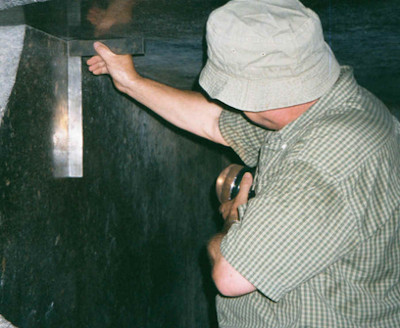
Figure 8
The image of the ZPAs in Domus de Janas Mandras Antine, fig.8(a), are shown to be straight. The remaining leg of a Castangia structure descending (near foregound) from a ZPA was also straight8. AnE harnessed that physical property of plasma to achieve precision in their stonework. Chris says, 'The underside of the lid and the inside wall, fig.8(b), of the box I found to be square, and finding that the squareness was achieved not just on one side of the box but both, raises the level of difficulty in accomplishing this feat.' With enough power, rock was transformed to plasma. Therefore, if a plasma beam was directed at the top of the box, a dead level surface would be created. Any imperfections would be planed off leaving a polished surface. The manufacture of the 'single point stability‘' vessel, fig.10(b) part 1, and funnel (6b) demonstrated AnE's complete control over the application of plasma. No other explanation can account for the type of precision Chris Dunn documents in the Serepeum and other places.

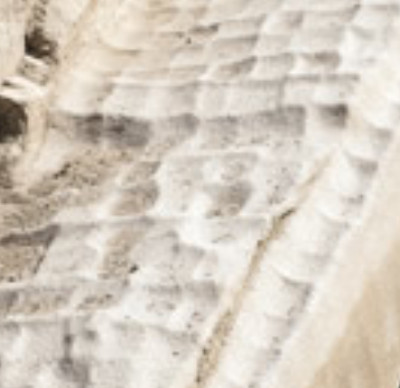
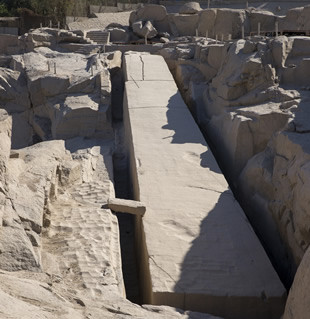
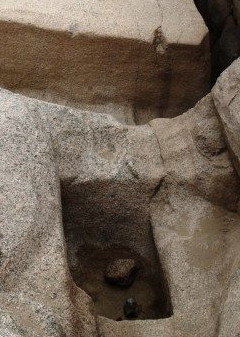
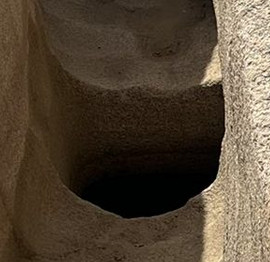
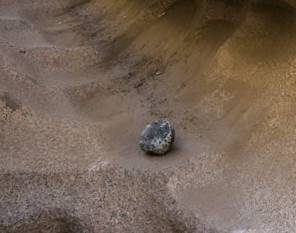
Figure 8
Another remarkable accomplishment of the AnE is the Unfinished Obelisk. The current narrative states it was brought to its present state of completion with the use of round stone balls called 'pounders', fig.9(f). The notion is absurd. The physical evidence does not match the assertion. Sir Petrie said bronze saws and drills were used to shape some of the stones he found. He was astonished at the speed with which the drills cut through stone. The unfinished obelisk explained how plasma was used to accomplish this.
The evidence found at the obelisk sustained the assertion that plasma was used to craft the granite monolith. In fig.9(a,b), there can be seen a series of depressions roughly patterned both length and width. The design is what would be expected if a type of abrader was used to grind off stone that had been 'softened' by plasma radiation. Because the depressions lack precision, the machine was only loosely controlled. The abrader was rotated 90 degrees to make the depressions that run along the edge of the trench in fig.9(b). In the top third of fig.9(b),there is an elevation change showing work stopped at this point. The shift might indicate the depth plasma radiation was effective in 'softening' the rock. Seven depressions were created as the abrader was moved across the width of the granite. Given the depressions loose alignment, fig.9(b) , the machine appeared to have been manually controlled.
Precise control was mandatory for sculpting the obelisk's shape. The sides are sharply defined in fig.9(a,c). Such precision would have demanded a solid framework from which to operate machinery. In fig.9(a,d,e), there are two rectangular pits probably for mounting such scaffolding, one near the apex and the other at the foot of obelisk. From the solidly anchored supports, straight lines of the obelisk were cut. The trenches on either side of the obelisk have the same type of abrasion pattern on their sides as those seen in fig.9(a,b). All of this work could only have been accomplished using plasma and machine(s).
The evidence on Sardinia left by the plasma connections resolves the contradictions in Egypt. Plasma enabled AnE to lift, move and shape stone. They had tens of thousands of years to perfect its use. Over that time period, they had thousands of years of experience adapting to the return of the ZPA, but not with the severity that occurred during the PC. It broke the connection between their culture and today's. Their experience with ZPAs must have restricted the use of metal to items that could be shielded, possibly in places like the stone boxes in the Serepeum9. Such restrictions also limited their technical progress because they missed the highly beneficial use afforded by metal. To confront the ZPA, will require a science based on veracity not litmus tested evidence. Book burning, narrative control, cockroach and soap-opera science is turning western scientific tradition into a museum diorama. What the Medici's started with the New Learning is being undone. To meet the challenge when the ZPAs return, veracity is needed.
The advanced civilization before the Ancient Egyptians.↩
Chris Dunn research can be found at:https://www.gizapower.com/. He has accrued a large amount of critical research that is barely touched on here.↩
see his youtube videos↩
Iconography and style in the statuary of Ramesses II; Mahmoud Awad Alsayd Alsayd Kassem↩
Laboury, Dimitri, 2010, Portrait versus Ideal Image. In Willeke Wendrich (ed.), UCLA Encyclopedia of Egyptology, Los Angeles. http://digital2.library.ucla.edu/viewItem.do?ark=21198/zz0025jjv0↩
This is a good example of what can be called soap-opera science. As in a soap-opera, endless vignettes are conjured up to provide fantasy explanations in place of scientific fact.↩
See Chris Dunn's website for examples of old saw cuts.https://www.gizapower.com/aburawash.html.↩
The Castangia structure is physically separate from the ZPA in the middle‘ distance.↩
The Serepeum may have been a sarcophagus production shop. This will be discussed in an upcoming article.↩

